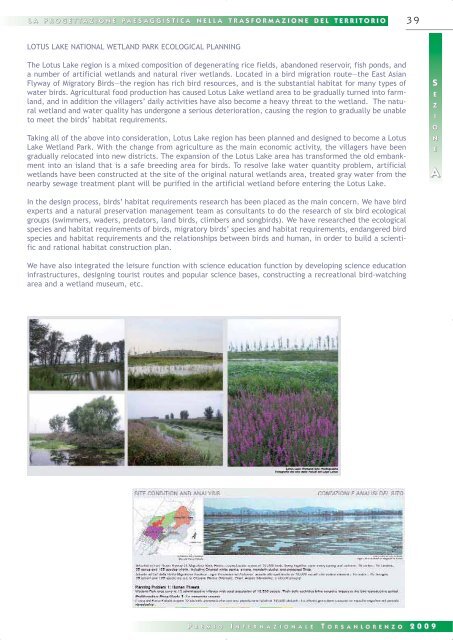torsanlorenzo
Scarica il pdf del TSL Informa Aprile - Maggio 2009 - Premio ...
Scarica il pdf del TSL Informa Aprile - Maggio 2009 - Premio ...
- No tags were found...
Create successful ePaper yourself
Turn your PDF publications into a flip-book with our unique Google optimized e-Paper software.
L A P R O G E T T A Z I O N E P A E S A G G I S T I C A N E L L A T R A S F O R M A Z I O N E D E L T E R R I T O R I O<br />
39<br />
LOTUS LAKE NATIONAL WETLAND PARK ECOLOGICAL PLANNING<br />
The Lotus Lake region is a mixed composition of degenerating rice fields, abandoned reservoir, fish ponds, and<br />
a number of artificial wetlands and natural river wetlands. Located in a bird migration route—the East Asian<br />
Flyway of Migratory Birds—the region has rich bird resources, and is the substantial habitat for many types of<br />
water birds. Agricultural food production has caused Lotus Lake wetland area to be gradually turned into farmland,<br />
and in addition the villagers’ daily activities have also become a heavy threat to the wetland. The natural<br />
wetland and water quality has undergone a serious deterioration, causing the region to gradually be unable<br />
to meet the birds’ habitat requirements.<br />
Taking all of the above into consideration, Lotus Lake region has been planned and designed to become a Lotus<br />
Lake Wetland Park. With the change from agriculture as the main economic activity, the villagers have been<br />
gradually relocated into new districts. The expansion of the Lotus Lake area has transformed the old embankment<br />
into an island that is a safe breeding area for birds. To resolve lake water quantity problem, artificial<br />
wetlands have been constructed at the site of the original natural wetlands area, treated gray water from the<br />
nearby sewage treatment plant will be purified in the artificial wetland before entering the Lotus Lake.<br />
S<br />
E<br />
Z<br />
I<br />
O<br />
N<br />
E<br />
A<br />
In the design process, birds’ habitat requirements research has been placed as the main concern. We have bird<br />
experts and a natural preservation management team as consultants to do the research of six bird ecological<br />
groups (swimmers, waders, predators, land birds, climbers and songbirds). We have researched the ecological<br />
species and habitat requirements of birds, migratory birds’ species and habitat requirements, endangered bird<br />
species and habitat requirements and the relationships between birds and human, in order to build a scientific<br />
and rational habitat construction plan.<br />
We have also integrated the leisure function with science education function by developing science education<br />
infrastructures, designing tourist routes and popular science bases, constructing a recreational bird-watching<br />
area and a wetland museum, etc.<br />
P R E M I O I N T E R N A Z I O N A L E T O R S A N L O R E N Z O 2 0 0 9



